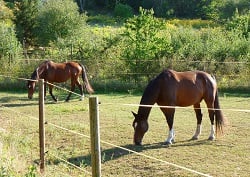
Farmers invest countless hours and dollars on livestock. The same amount of effort and planning should be invested into the boundaries that keep the livestock safe and secure. Livestock fencing needs to be strong and long lasting in order to protect your investment. High tensile fencing covers both needs and is cost effective when compared to barbed wire.
When to Use It
High tensile wire fencing should be used if you’re looking to keep cattle, sheep, horses, or other animals in. High tensile wire fencing also keeps the deer, bears, and coyotes out. High tensile wire fencing should be used if you’re looking for a long-term solution. The heavy posts of this fence are driven deep into the ground, which doesn’t make this a temporary fix. It can be used whether you’re looking for an electric fence or not. For larger cattle, high tensile wire fencing has an elasticity element that will slow the cattle down without completely damaging the fence. It is the more economical choice, is easier on livestock, and should be used when looking to keep livestock in and keep large pests out.
How to Install It
- Dig Holes for Corner Posts. Make sure to dig holes deep enough to stabilize and support your posts.
- Set Corner Posts. Use fencing staples to further secure corner posts, by using the fencing staples in an upward direction you’ll add additional protection for the posts to be pulled out.
- Build Braces. This type of fence puts a great deal of strain on poles and by building and installing the braces you’ll release some pressure from the poles. Fencing staples can also be used here on the end of the brace and on the bottom of the post so the cable can be run through here.
- Space out Posts. For spacing advice and tips read another blog from FASCO America® here.
- Install Line Posts. These are the posts that run the length of your fence.
- Install Insulators for Electric Fences. Insulators are designed to fasten electrified wire to posts without losing energy through the post which could cause shorts in the circuit. They come in either plastic or porcelain and should be purchased according to the type of post and the type of wire being used. Using a good insulator is important to maintain the performance of your fence.
- Attach Wire. Continue this step for every post and corner of the fence.
- Double Check. Tighten/loosen wire as you go and be sure the wire is straight.
When installing your high tensile wire fence be sure to do it right the first time by using the proper tools and procedures. The BECK® Fence Stapling System includes air-driven fence stapling that gives superior holding power and corrosion protection for wire fencing projects.
.svg.png)

